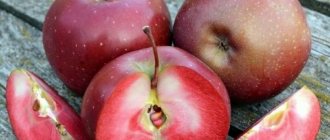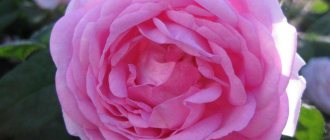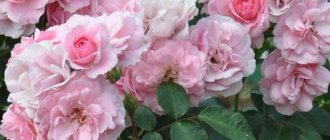You've probably heard about rose petal jam or even tried it, but you're unlikely to make it a mandatory part of your diet. And in vain.
Photo: Depositphotos.com. Author: belchonock.
Without exaggeration, roses are a storehouse of useful substances. Since ancient times, healers have used extracts and decoctions of rose petals to treat nervous diseases, bleeding gums, digestive disorders, stomach ulcers, ENT diseases, and to improve immunity.
There is evidence that rose oil is useful in cleansing the body of toxins; its regular use reduces the intensity of allergic reactions, softens the course of bronchial asthma, and is effective for diseases of the liver and gall bladder.
Use in aromatherapy
Good rose oil is very expensive. It is included in almost every bottle of modern perfumery. And only 2% of aromatic products do without it.
Rose oil is widely used in aromatherapy. Agree, it’s nice to add a few drops of divine floral fragrance to the aroma lamp and lie down with your eyes closed, imagining yourself in the place of an ancient Egyptian goddess. This smell calms and relaxes, gives long-awaited peace and confidence in the future, it helps with insomnia and increased nervousness.
Recipes
Photo: Depositphotos.com Author: belchonock
Russian people are accustomed to adding dried rose and rose petals to tea. The main thing is not to use purchased roses for these purposes. They contain substances harmful to the human body, including hazardous chemicals. Do you like to leisurely sip pink tea from your favorite porcelain mug? Roses grown in your own summer cottage or special small buds for tea parties will suit you.
Jam
Another extremely tasty and healthy thing is rose jam. It is found both in its pure form (only sugar and fresh petals are involved in the preparation process) and as part of multi-component jams. The most popular store-bought option is strawberry-pink jam.
For the syrup you will need another 1 kg of sugar, the juice of half a lemon and 1 glass of boiled water. Mix all this, bring to a boil and add the pre-prepared base for jam. Cook until the petals become soft. Sign of readiness: the jam should stop squeaking on your teeth.
Honey based on rose petals is highly valued because it helps with severe lung diseases, tuberculosis, fever, and in the postoperative period. In Europe and America you will have to pay a tidy sum for it, but you can make honey from roses at home.
Pour 250 g of rose petals into 1 liter of boiling water and let it brew for 12 hours. Strain through clean gauze folded in several layers. Add a 750-gram jar of honey to the resulting liquid and bring to a boil over low heat. Take 1 tbsp. l. three times a day.
Vinegar
In the autumn-winter season, it's time to stock up on folk remedies against sore throat and tonsillitis. One simple and effective remedy is rose vinegar.
Antibacterial properties will help you and your children cope with the disease.
Rose has an antiseptic, anti-inflammatory, anthelmintic, sedative, wound-healing, and general strengthening effect on the body. This alone is enough to find a place for a rose bush in your summer cottage.
You've probably heard about rose petal jam or even tried it, but you're unlikely to make it a mandatory part of your diet. And in vain.
Photo: Depositphotos.com. Author: belchonock.
Without exaggeration, roses are a storehouse of useful substances. Since ancient times, healers have used extracts and decoctions of rose petals to treat nervous diseases, bleeding gums, digestive disorders, stomach ulcers, ENT diseases, and to improve immunity.
There is evidence that rose oil is useful in cleansing the body of toxins; its regular use reduces the intensity of allergic reactions, softens the course of bronchial asthma, and is effective for diseases of the liver and gall bladder.
Use in aromatherapy
Good rose oil is very expensive. It is included in almost every bottle of modern perfumery. And only 2% of aromatic products do without it.
Rose oil is widely used in aromatherapy. Agree, it’s nice to add a few drops of divine floral fragrance to the aroma lamp and lie down with your eyes closed, imagining yourself in the place of an ancient Egyptian goddess. This smell calms and relaxes, gives long-awaited peace and confidence in the future, it helps with insomnia and increased nervousness.
Recipes
Photo: Depositphotos.com Author: belchonock
Russian people are accustomed to adding dried rose and rose petals to tea. The main thing is not to use purchased roses for these purposes. They contain substances harmful to the human body, including hazardous chemicals. Do you like to leisurely sip pink tea from your favorite porcelain mug? Roses grown in your own summer cottage or special small buds for tea parties will suit you.
Jam
Another extremely tasty and healthy thing is rose jam. It is found both in its pure form (only sugar and fresh petals are involved in the preparation process) and as part of multi-component jams. The most popular store-bought option is strawberry-pink jam.
For the syrup you will need another 1 kg of sugar, the juice of half a lemon and 1 glass of boiled water. Mix all this, bring to a boil and add the pre-prepared base for jam. Cook until the petals become soft. Sign of readiness: the jam should stop squeaking on your teeth.
Honey based on rose petals is highly valued because it helps with severe lung diseases, tuberculosis, fever, and in the postoperative period. In Europe and America you will have to pay a tidy sum for it, but you can make honey from roses at home.
Pour 250 g of rose petals into 1 liter of boiling water and let it brew for 12 hours. Strain through clean gauze folded in several layers. Add a 750-gram jar of honey to the resulting liquid and bring to a boil over low heat. Take 1 tbsp. l. three times a day.
Vinegar
In the autumn-winter season, it's time to stock up on folk remedies against sore throat and tonsillitis. One simple and effective remedy is rose vinegar.
Antibacterial properties will help you and your children cope with the disease.
Rose has an antiseptic, anti-inflammatory, anthelmintic, sedative, wound-healing, and general strengthening effect on the body. This alone is enough to find a place for a rose bush in your summer cottage.
The rose is considered one of the most beautiful flowers on Earth. The beneficial properties of roses and contraindications for use have been known since ancient times. It is used in perfumery, cosmetology, cooking and other fields.
The use of roses in cosmetology
Almost any cosmetic product can be prepared using roses. Petals are usually used for this.
Rose oil
Real rose oil cannot be prepared at home, since in industry it is created using a rather complex technology by distilling essential oil petals with water steam. However, you can make a similar cosmetic product (oil infusion) with your own hands if you pour fresh rose petals with a strong aroma with olive oil or any cosmetic oil (grape, peach, almond).
The container must be closed with a lid and placed in a dark place for 1-2 weeks. After this time, the oil can be applied to the skin to give it firmness and elasticity.
Refreshing pink face lotion
Fill a glass of rose petals with 200 ml of vodka, cover with a lid and place in a dark place for 10 days. Then strain the mixture and add 2 tsp. boiled water. Wipe your face with the resulting lotion morning and evening.
Rose infusion for dry and aging skin
Finely chop the fresh petals. 2 tbsp. Pour a glass of boiling water over the resulting raw material, cover with a lid, wrap the container in a towel and leave for 25-30 minutes. Then cool the infusion and strain.
Wipe your face with it using a cotton pad or spray it with a spray bottle. The same remedy can be used in the form of ice cubes.
Nourishing rose face mask
Grind the dried petals into flour, 1 tsp. mix the resulting raw materials with egg white and 2 tsp. cream. Let the mixture sit for a few minutes, then apply the mask to clean skin of the face, neck and décolleté. After 20 minutes, rinse with cool water.
What are the benefits of rose petals?
The maximum concentration of microelements is observed in the flower early in the morning. That is why it is recommended to collect them before the sun rises.
Even in ancient times, women knew the benefits of rose petals. They loved to take baths with milk and petals. This procedure has a very positive effect on the body. It will make the skin radiant, well-groomed and velvety, and calms the nervous system.
Rose petals contain a lot of vitamin C, B, calcium, carotene, and iron. The last trace element is especially important. Since it has a positive effect on the hematopoietic system.
Having skin diseases, shallow wounds or other damage, you can also use the petals to achieve an antibacterial effect. Powdered flowers help cure oral diseases.
How roses are used by humans in cosmetology is known to many. It takes excellent care and gives youthful, silky appearance to the delicate skin of the face. You may have noticed that stores sell a lot of different cosmetics based on such petals. But it won’t be difficult to prepare creams and masks at home yourself. Knowing the appropriate proportions and recipes, you will take care of your beauty and save a decent amount.
In addition to the petals, rose fruits are also used in medicine. They contain many useful microelements that help fight various diseases.
Pink water
Making this product is not difficult. At the same time, it quite effectively fights the first signs of aging.
Cooking process:
- Take rose petals, fill them with water, and heat them slowly.
- Over time, you will see that the water has become colored and the petals have become transparent. This means that they gave the liquid all its beneficial properties. Place the prepared rose water in the refrigerator after it has cooled and feel free to use it. This way you can get rid of a large number of wrinkles.
- Freeze the resulting liquid in the freezer in a special ice container. Use pieces of ice to wipe the delicate skin of your face and neck. This is the best prevention of aging.
In addition, you can add the resulting liquid to your favorite cream, giving it a moisturizing effect. A decoction of rose petals is also good for hair. It makes them beautiful and voluminous.
Wild rose in folk medicine
Rose hips are extremely rich in vitamins; in folk medicine they are most often used for hypertension, heart and liver diseases. Also, these red fruits are effective as an anti-inflammatory and tonic agent, a cure for scurvy and disorders of the gastrointestinal tract. The fruits are included in expectorant herbal teas and liver teas.
The flowers of this plant are also often used by traditional healers. Thanks to the rich content of flavonoids, anthocyanins, tannins and essential oils, these soft pink petals serve as a remedy for skin diseases, sore throats, and stomach disorders. Cosmetologists recommend washing your face with infusions of rosehip petals to refresh its tone and smooth out wrinkles. The oil obtained from fresh petals is added to creams and soaps.
Thanks to the presence of many vitamins, pectin, amino acids and organic acids, rosehip extract effectively moisturizes, softens and smoothes the skin, promotes relaxation of epidermal cells. Fruit acids contained in the fruit are effective in treating acne and pimples. And to strengthen nails and hair, you can use masks using wild rose fruit oil.
Medicinal properties of roses
Roses are used not only in cosmetology, but also medicinal products prepared on the basis of this amazing plant are widely used. Mostly medicines are made from the buds.
The beneficial properties of rose fruits are as well known as the petals. Special decoctions are prepared from them, which perfectly help overcome diseases such as tonsillitis, stomatitis, conjunctivitis, rheumatism, bronchitis, rhinitis, diarrhea. In addition, it can be used as an antiallergic and antibacterial agent. For colds, it helps heal the respiratory organs.
Recipes for preparing medicines are quite simple, do not take much time, and are also quite accessible. So, if you are suffering from various diseases of the oral cavity, for example, stomatitis or other inflammatory processes, it is enough to rinse your mouth with tincture twice a day.
Uses of tea rose fruits
Some species and varieties of R. Thorns vary in size, shape, and color. Sometimes on the same shoot the thorns are different in shape. In garden roses, the thorns are often hooked and curved. The color of the spines varies and therefore cannot be considered a typical feature. However, in R. In certain types of rose hips, the thorns are very decorative and noticeable from afar. The most unusual thorns are on the rose pteracanthus R. The leaves are alternate, imparipinnate, compound.
Almost all wild roses have smaller leaf blades than garden roses. The leaf consists of , , , 13 or 15 leaflets attached to a common petiole. At the base of the petiole there is a stipule attached to it. The number, size and shape of leaves and stipules serve as a characteristic feature of individual types of roses. R has small leaves. The shape of the leaflets is determined mainly by the ratio of length and width. Diversity is observed within the oval type.
The leaves are pubescent in ancient varieties and bare on both sides in most modern ones. Rose leaves are rust R. The color of the leaves varies within the main green color, but in roses from different groups it is specific.
The color of the leaves is: light green, green, dark green. The young leaves of many varieties of roses are bronze or purple. The texture of the leaves is distinguished: matte, semi-matte, shiny, semi-shiny, leathery.
Many modern varieties have shiny leaves, while wild ones have no shine, with the exception of R. Shine gives the leaves of roses a decorative appearance and for some groups is a morphological feature.
Beneficial properties of roses and contraindications to the use of tea
This amazing flower has a unique aroma and surprisingly delicate texture of the petals. You need to dry the buds outdoors, always in the shade so that they are not exposed to direct sunlight. You can store harvested tea rose petals for a year, and they will retain all their healing properties. But before using, you should familiarize yourself with the benefits and harms of tea rose in a particular case.
Tea rose has the following effects:
- relieves pain;
- removes waste and toxins from the body;
- has an antibacterial effect;
- helps restore normal intestinal microflora;
- fights diarrhea and constipation;
- normalizes liver function;
- calms down nervous excitement;
- helps normalize hormonal levels.
But the medicinal properties of roses, like any drug, also have certain side effects and contraindications that should be taken into account when self-medicating. First of all, you need to be extremely careful if you are prone to allergic reactions. Due to the large amount of essential oils, the petals can cause allergies.
We do not recommend self-medication during pregnancy or lactation.
Any medications can be used in this situation only as prescribed by the attending physician. In addition, decoctions from this flower should not be given to small children under three years of age.
Rose petal tea
Very often you can find this amazing flower in garden plots. Therefore, many are interested in what are the benefits of roses? Often, to combat depression, stress and confusion, it is enough to drink delicious, aromatic, soothing tea. A warm drink made from rose petals is ideal for this purpose. It tastes very delicate, has a pleasant smell, and has a calming effect. In addition, petal tea has beneficial properties. It has a positive effect on the body. This infusion fills you with new strength. It normalizes the functioning of the heart.
Also, a drink made from tea rose petals is used for:
- colds;
- pathologies of the gastrointestinal tract;
- stomach upsets;
- ailments of the respiratory organs.
For flu and severe cough, you can brew rose petals as an expectorant. For inflammatory processes and diseases of the oral cavity, it is useful in a duet with honey.
Medicinal properties of berries
Rosehip has many medicinal properties. Wild rose is one of the few plants, all of whose components are used in traditional medicine.
Berries have the following healing effects on the body:
- Painkillers. The fruits relieve spasms and relax the walls of blood vessels.
- Decreased pressure. The product significantly improves the permeability of the circulatory system.
- Relieving swelling. The variety removes excess water from the body.
In the form of a rinse, an infusion based on berries kills microbes in the oral cavity - it is used for toothache and gumboil. The product also copes with bad breath.
In addition, berries strengthen the immune system. It is recommended to drink decoctions based on the product during cold periods to reduce the risk of disease.
Chinese rose is the most suitable variety for brewing a drink
Freshly prepared tea from this flower helps cleanse blood from blood clots. Helps to recover after drinking large amounts of alcohol, relieves men from problems with potency.
Today, many people suffer from cardiovascular diseases and constant surges in blood pressure. Tea made from Chinese rose petals will help cope with such problems. It is also recommended to take it to get rid of swelling of the limbs. But dry rose leaves located near the buds must be removed when brewing.
To brew this drink, it is recommended to use water no more than 80°C. It infuses for about five minutes. In combination with jasmine, this tea helps fight depression, puts thoughts in order, and promotes weight loss.
Useful properties of rose hips
The beneficial properties of rose hips were known back in ancient times. For a restful sleep, the ancient Romans stuffed their pillows with the petals of this plant. Today, rose hips are known as one of the richest sources of vitamin C (this vitamin is approximately 20-30 times more than that found in citrus fruits). Just 1-3 fresh berries are enough to cover the body's daily need for ascorbic acid. Meanwhile, long-term drying of fruits, even at low temperatures (about 40 degrees Celsius), leads to a loss of almost 75 percent of vitamin C.
It is important to understand that the longer fruits are stored, the less nutrients remain in them.
In addition to ascorbic acid, these red berries supply the body with vitamins P, , , B substances, bioflavonoids, carotenoids, tannins and pectins, carbohydrates, organic acids, essential oils and mineral salts.
These tart berries are useful in treating dysentery and diarrhea. Flavonoids combined with vitamin C have powerful antioxidant properties. Rose hips are also extremely useful in the fight against colds and infectious diseases, flu, and pneumonia.
Wild rose has mild diuretic and laxative properties, and the presence of iron makes it useful for anemia and bleeding.
Diseases and conditions for which it is useful to consume rose hips:
- pregnancy;
- weakened immune system;
- fragility of blood vessels;
- kidney and liver stones;
- catarrh of the gastrointestinal tract;
- diarrhea;
- stomach ulcer;
- rheumatism;
- burns;
- scurvy;
- fragility of blood vessels.
Hibiscus is also a rose
The well-known red hibiscus tea, which can be purchased without problems in every store, is made from Sudanese rose. In ancient times, this drink was considered very rare and elite. Only pharaohs could afford it. Today it is sold in almost every store. To prepare a decoction of rose petals, you can use hibiscus exclusively or combine it with any other type of tea.
Vodka tincture of rose petals
From roses you can easily prepare an excellent tasty vodka tincture with a pleasant aroma. It is not difficult to do; the method is quite simple and does not require a lot of financial costs and effort.
To prepare an alcohol tincture from rose petals you will need:
- 50 grams of freshly picked rose petals;
- 3 grams of citric acid;
- 100 grams of sugar;
- 50 grams of clean water;
- 500 grams of alcohol or vodka of good proven quality.
Cooking process:
- The petals need to be sorted out so that they are not spoiled, dried out and withered, with black spots.
- Then wash them, dry them, and grind them using a meat grinder or blender.
- Place in a suitable container. Put sugar, citric acid and water there. Pour vodka or alcohol over everything and mix thoroughly. Close the lid tightly. Leave the container with the drink in a cool, dark place for about fourteen days. Shake the jar every three days.
- After two weeks, pass the tincture through a filter and remove the pulp. If necessary, add some more sugar, stir and place in the refrigerator for ten days. After this time, pass the tincture through the filter again, and you're done.
The longer it infuses, the more pleasant and pronounced the aroma will be. Thanks to this drink, you can not only enjoy the pleasant, delicate taste yourself, but also proudly treat your guests, because such a tincture will not leave anyone indifferent. But the use of tincture of rose petals with vodka is not recommended for people prone to alcoholism.
Making rose jam
To prepare aromatic rose jam, you will need the following ingredients: 600 g of sugar, 300 g of fresh rose petals, and six glasses of water.
Sort the petals and rinse. Dry them on a towel, then place them in a bowl and sprinkle with two tablespoons of sugar.
Rub the petals thoroughly with your hands and drain the juice into another bowl.
Bring the water to a boil and add the remaining sugar. Mix thoroughly and, without stopping stirring, cook for two minutes. After this, strain and cool.
Pour the prepared syrup over the petals. Bring to a boil over high heat. Then reduce the heat to low and simmer for six minutes, stirring and skimming off the foam.
Add the juice of rose petals to the jam and simmer for another quarter of an hour until the syrup thickens.
Rose for beauty and youth
Rose has been used in cosmetology since ancient times. In the modern world, a huge variety of skin and hair care cosmetics are sold based on this flower. This is not surprising, because rose oil has many beneficial substances. In addition to store-bought ones, you can easily prepare such cosmetics yourself.
Why are rose petals needed in cosmetology:
- make hair shiny and strong;
- fight wrinkles and aging skin;
- give the skin a uniform shade;
- tighten pores;
- have a moisturizing effect;
- rose extract in cosmetology helps get rid of dandruff and various dermatitis;
- nourish the cover, gives it vital energy;
- increase skin elasticity and firmness;
- help get rid of stretch marks and scars.
To moisturize the skin and give it freshness, you need to apply the petals and hold them for half an hour. As for the benefits and harms of a bath with rose petals, cosmetologists recommend similar beauty procedures. And dermatologists are there to eliminate skin diseases. This will not only add vital energy, but will also help you relax and take your mind off the problems in everyday life. If you are not attracted to floating petals, then prepare a rose decoction in advance and pour it into the water. In the same way, you can simply wipe the skin with a cotton swab.
Prepare half a glass of petals, pour a glass of boiling water over them, close the lid tightly and let it brew for half an hour. This solution helps well with acne, insect bites, and allergic reactions.
As you can see, this flower has a large number of beneficial properties. Rose is used in folk medicine, cooking, and cosmetology. However, do not forget that there are certain contraindications for use.
Applications of berries
Thanks to the large number of useful products, rose hips are widely used in cosmetology and medicine. The fruits of the variety are unique - they are almost never eaten fresh, but many different products are made based on the product.
In cosmetology
Masks and scrubs are made using fresh fruits. Wild rose oil is used in case of prolonged rashes. It is also used for dry lips - the product moisturizes the skin and reduces the risk of wounds and cracks.
Rosehip-based cream is used to nourish the skin - the chemical composition of the fruit accelerates the regeneration and renewal of the epidermis. Masks also remove wrinkles.
For those wishing to lose weight, berries will help speed up metabolism. In this case, it is recommended to brew tea according to this recipe:
- fresh ginger - several small pieces;
- 30 grams of rose hips;
- a handful of raisins.
The ingredients are poured with boiling water and left for 3 hours. Drink tea warm, 20 minutes before eating. Nutritionists recommend combining the infusion with proper nutrition.
In medicine
Rose hips are widely used in both traditional and folk medicine. The berries are used for various medicinal decoctions and infusions:
- Healing infusion. Take 300 grams of fruit per liter of hot water. Mix the ingredients and leave in the thermos for 2 hours. We filter the drink, after which it can be consumed up to 3 times a day. The infusion lowers blood pressure, treats acute respiratory infections and relieves swelling.
- Rose hip decoction. For the drink, the same proportions are used as for the infusion, but we do not leave the liquid in a thermos, but bring it to a boil over low heat. This remedy has a gentler effect on the human body and can be given to children.
Such recipes are used not only as drinks, but also to improve skin. The decoction can be used to wash wounds; it disinfects the surface well and relieves inflammation. The infusion is also used as a rinse; it is used to wash the nasopharynx for sinusitis.











